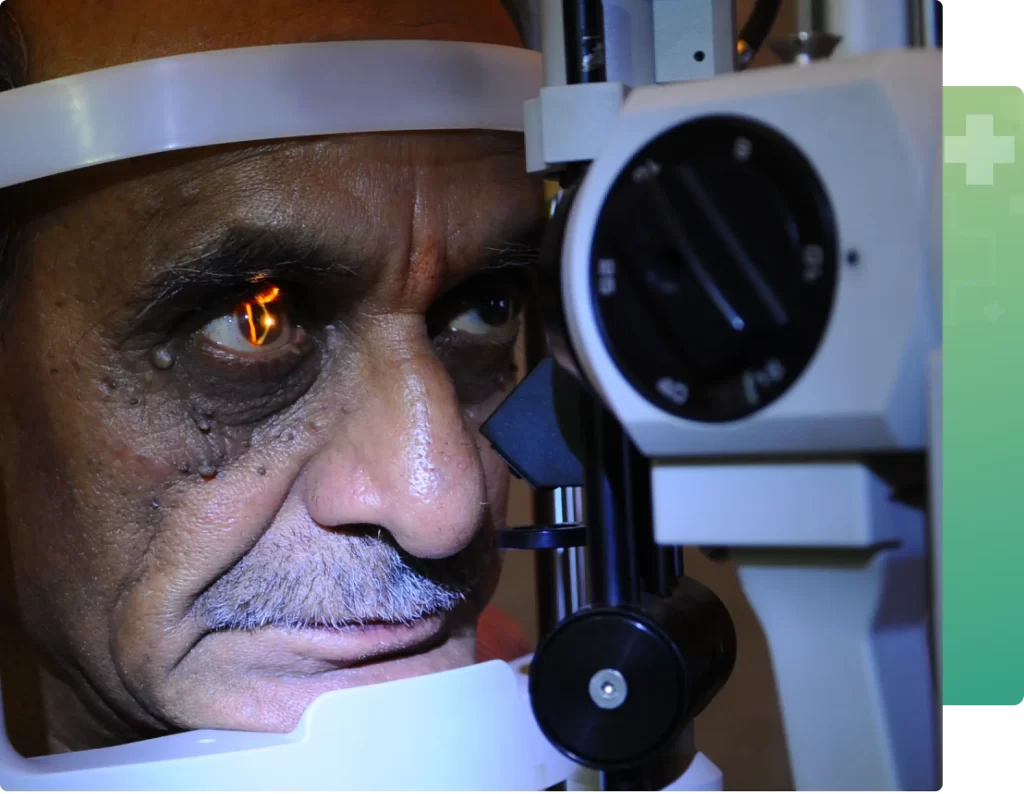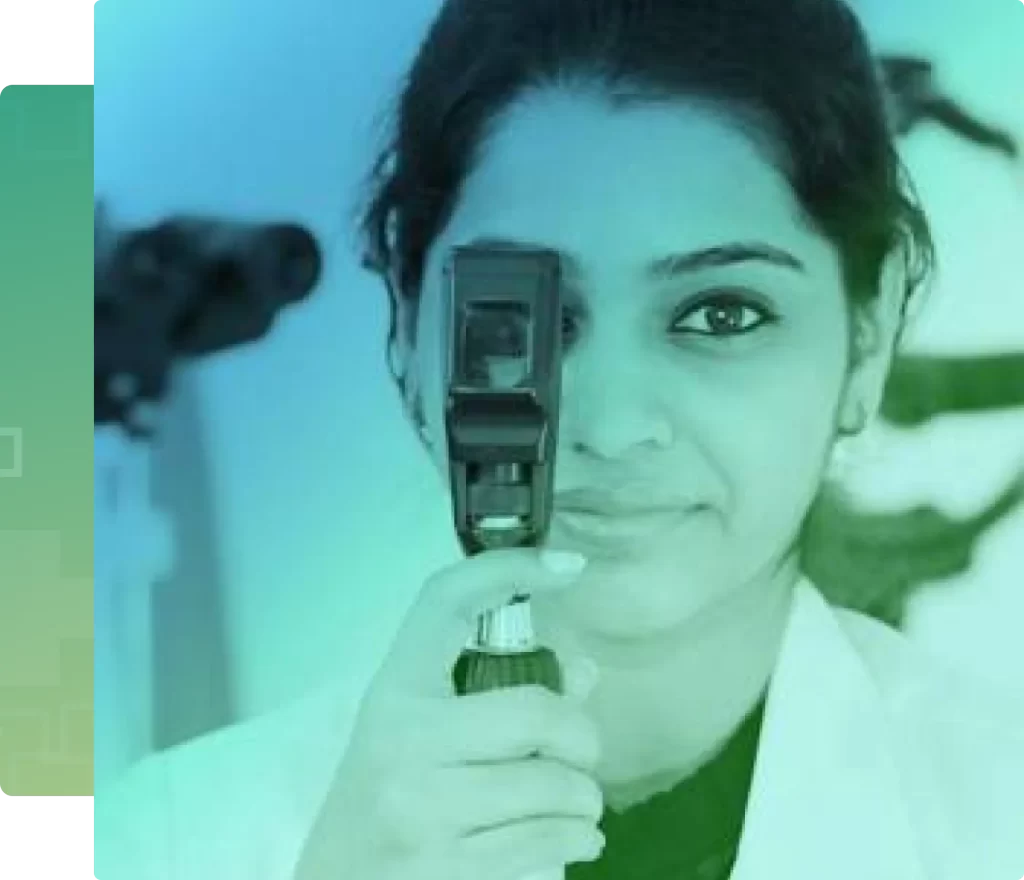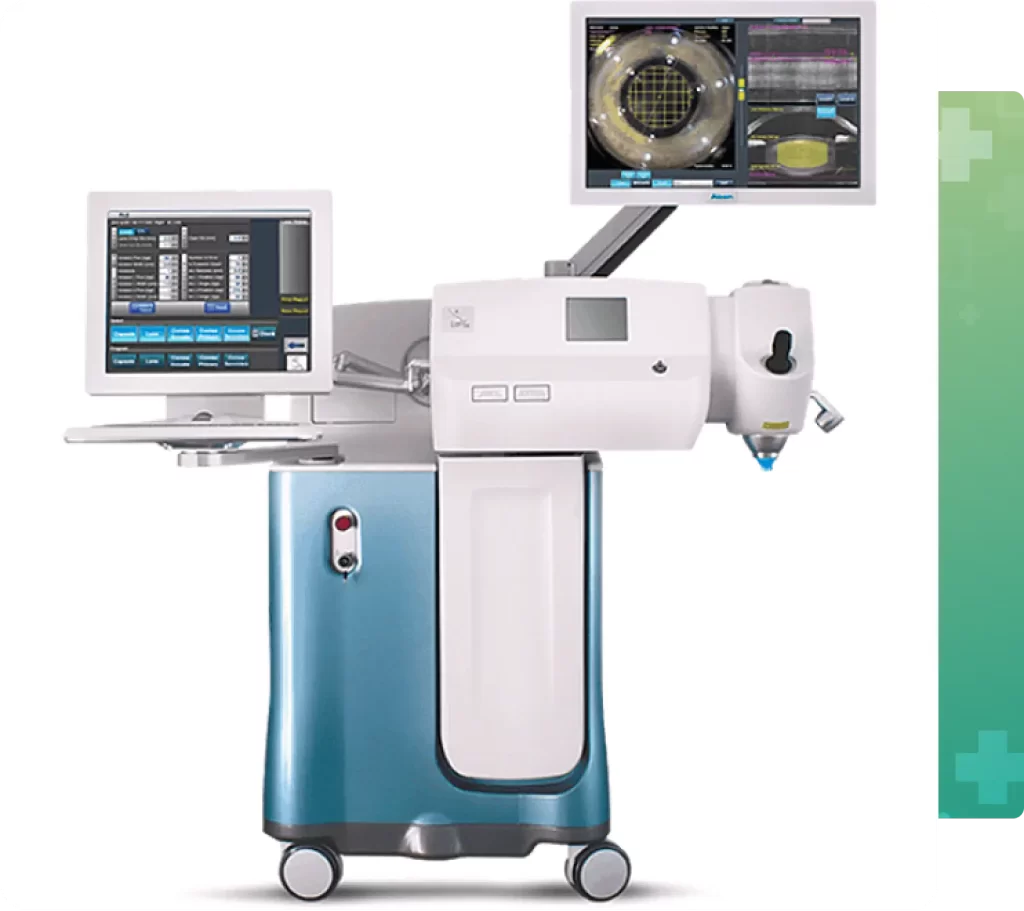Cataract
Cataract is a leading cause of age-related preventable blindness worldwide
Did you know that an estimated 20 lakh new cataract cases are seen in India every year and that cataract blindness can be completely avoided?
Cataract is a commonly occurring vision problem that develops as you grow older, due to clouding of the eye’s natural crystalline lens caused by a gradual build-up of proteins. 80% of the blindness in India is due to cataract. Most people develop cataracts after the age of 60, in one or both eyes. Cataract symptoms include hazy, blurred or double vision, sensitivity to light and glare, difficulty seeing in poor lighting conditions, difficulty in distinguishing changes in contrast, and fading of colours. Without cataract treatment, your vision will continue to deteriorate and affect daily activities, such as your ability to read and drive. An ophthalmologist can provide you with an accurate cataract diagnosis and advice you on cataract treatment options.


Cataract is curable. Don’t let cataract symptoms affect your day-to-day living and quality of life.
Cataract eye surgery is one of the most commonly performed procedures worldwide, where the cloudy natural lens is removed and replaced with an artificial intraocular lens for clear vision. Advances in cataract surgery techniques have made this procedure efficient and safe, with more predictable refractive outcomes, minor or very rare cataract complications, and quicker cataract surgery recovery time. Patients who visit Narayana Nethralaya for cataract surgery are provided with an individualized treatment plan by our cataract surgeons based on their age, the severity of cataract vision loss, and daily activities to obtain the best vision possible post-cataract surgery.
Cataract Surgery at
Narayana Nethralaya
Narayana Nethralaya is a one-stop solution for cataract surgery with expert cataract diagnosis, cataract treatment and cataract post-surgery care
Detailed preoperative cataract assessment and patient counseling, advanced diagnostic equipment, state-of-the-art operation theatre complex, world-renowned cataract surgeons, and meticulous cataract post-surgery care makes Narayana Nethralaya the best choice for Cataract Surgery. Our highly specialized cataract surgeons are recognized as leading practitioners in their field and are experienced in handling cataract cases with varying complications such as diabetes, glaucoma, hypertension, age-related macular degeneration, retinitis pigmentosa, corneal scars, trauma, childhood cataract, etc. NN is one of the preferred choices for complicated cataract surgeries, especially post traumatic and high-risk referral patients, and those who may have previously undergone cataract removal surgery.
Cataract Symptom Checker
Cloudy or blurred vision

Distorted or double vision

Sensitivity to light and glare

Cloudy or blurred vision

Distorted or double vision

Sensitivity to light and glare

Cataract surgery procedure
At Narayana Nethralaya cataract patients can avail the most cutting edge technology in the field of cataract laser surgery – Femtosecond Laser-Assisted Cataract Surgery on the LenSx platform – where a large part of the cataract removal is automated with a computer-controlled laser instead of hand-held instruments. This reduces the possibility of human error or complications during the cataract procedure and increases the levels of safety, precision, and predictability for early healing, better vision outcomes, and patient safety. We offer a wide range of intraocular lens for cataract surgery from Monofocal to Multifocal and Premium Toric IOLs, to cater to your vision requirement and budget.

Cataract Surgery Lens Options
Monofocal Lens
With traditional cataract surgery, you will receive a standard monofocal lens that will provide good distance vision, but you will still need glasses for close and possibly for intermediate vision.
Astigmatism-Correcting Lens
If you have astigmatism and choose cataract surgery with an astigmatism-correcting monofocal lens, you will eliminate both cataracts and astigmatism, but you will still need glasses for improved vision.
Multifocal Accommodative Lens
With cataract surgery, a multifocal accommodative lens can improve near, far, and intermediate vision, allowing most patients to function with little need for glasses.
Extended depth of focus IOLs
EDOFs (Extended depth of focus IOLs ) are the Alcon Vivity IOL, Tecnis Eyhance IOL, Zeiss AT LARA. These IOLs are slightly different from Trifocal IOLs in the context that while trifocals aim at correcting near, intermediate and distance vision,
Cataract surgery Techniques

Phacoemulsification
Phacoemulsification – is a sutureless type of cataract surgery wherein a machine is used to emulsify (break down and remove) the cataract with a special probe that utilizes ultrasound energy. As the entire cataract is emulsified in situ, a smaller incision of 2.4-2.8 mm is sufficient for this cataract procedure. A smaller incision size results in lesser astigmatism and thus better quality of vision for the patient. A foldable intraocular lens is implanted after the emulsification of the nucleus. This surgery is performed under topical anesthesia as a daycare procedure following which the patient is free to go home. This is a painless and modern cataract surgery technique that offers quick healing and cataract surgery recovery.

MICS (Micro Incision Cataract Surgery)
MICS (Micro Incision Cataract Surgery) – In this type of advanced cataract surgery, the standard phacoemulsification is performed with an incision size ranging between 2.2-2.4 mm. The smaller incision size in this procedure as compared to the standard phacoemulsification has the benefit of faster healing and induces lesser astigmatism.

Femtosecond laser-assisted cataract surgery (FLACS)
Femtosecond laser-assisted cataract surgery (FLACS) – is an innovative bladeless surgical option for cataract In this type of cataract surgery a laser machine is used first to make the incisions, create an opening in the lens capsule and liquefy the nucleus. The patient is then shifted to the operating room and the cataract surgery is completed. The initial use of laser to make the incisions has the advantage of more precise incisions as compared to manual incisions. Also, as the cataract is already softened by the laser, lesser energy is used during the actual phacoemulsification surgery. This high-end procedure is the latest advancement in the field of cataract surgery and benefits the patients in terms of lesser collateral damage to surrounding tissues, faster healing and improved visual outcomes.
Cataract treatment for people with special needs
Narayana Nethralaya provides specialized cataract diagnosis, cataract treatment, and surgical care for disabled patients, and those with special needs such as learning disabilities.


Cataract treatment for International Patients
Advanced quality care at great affordability and a smooth and hassle-free patient process have made Narayana Nethralaya the preferred choice for international cataract patients from across the globe, both from developed and developing countries.
Cataract Brochure
Cataract Brochure (English)
Cataract Brochure (Kannada)
Now Eye Know Videos
faqs
Pre Operative Instructions for Cataract Surgery
What should I do prior to the day of cataract surgery?
It is important for you to follow all the cataract surgery pre op instructions given to you by your doctor. Your surgeon may advise you not to drink alcohol for 12 hours before the cataract eye surgery. If you are on other medications, your doctor may ask you to stop taking them or alter the timing of the medications prior to the cataract surgery procedure. You may be instructed to use cataract surgery pre op medications or pre cataract surgery eye drops to prevent infection. A good night’s rest is important before the day of the cataract operation.
Pre-cataract surgery eye drops – should I apply eye drops on the day of cataract surgery?
Yes. Ensure that eye drops are applied as directed. Apply only one drop at a time to the suggested eye and give a gap of at least 15 minutes between drops. Note that your vision will be blurred after you apply Tropicacyl Plus eye drops on the day of cataract surgery procedure. Kindly take care accordingly.
Can I take my regular medication on the day of cataract surgery?
If you are on medication for systemic illness, please continue your regular medication, unless specifically instructed otherwise by your ophthalmologist.
Can I shave on the day of cataract surgery?
Yes. You can shave on the day of cataract removal surgery.
Can I bring an attendant on the day of cataract surgery?
Yes. You can bring 1 attendant over the age of 18 years with you on the day of the cataract eye surgery. Children and infants are not allowed.
Why do I need the eye drops before cataract surgery?
Starting the eye drops before cataract removal gives your eye a better chance to heal from the inflammation caused by the cataract extraction and to fight infection.
Can I have breakfast on the day of cataract surgery?
Yes. You should have breakfast (normal diet) before coming for the cataract procedure.
Can I wash my hair on the day of cataract surgery?
Yes. Please wash your hair on the day of cataract surgery as you will not be able to do so for 1 week after the cataract surgery. However, oil should not be applied to your hair.
What clothes should I wear on the day of cataract surgery?
Wear loose, comfortable clothing, preferably a short sleeve shirt or blouse that button or zip up the front,and comfortable shoes when you come for cataract surgery.
Post Operative Instructions for Cataract Surgery
What to expect after cataract surgery – Will I have any pain in my eye after cataract surgery?
Cataract surgery after effects – There is no severe pain associated with cataract removal surgery. You may experience post cataract surgery symptoms such as minor discomfort, blurry vision, watering and an itchy feeling, or a little soreness in your eye for a couple of days after cataract surgery. While some patients do not feel any major discomfort, others may feel like they have an eyelash or grain of sand in their eye. Your eye may also be slightly red after the cataract extraction. However, most of these cataract surgery recovery symptoms will settle within a few days. You can take an over-the-counter pain relieving tablet to help ease any pain.
Post-cataract surgery follow-up – When should I come back for follow-up visits post cataract surgery?
Your post cataract surgery follow up visits will be scheduled for 24 hours after the cataract removal, one week after the cataract surgery, and one month after the cataract procedure.
How long do I have to keep my eye covered after cataract surgery?
You should wear indoor protective eye glasses for 24 hours and the outdoor protective eye glasses for 1 month after cataract surgery. It is advisable to remove your glasses while lying down or sleeping.
What are the usual post-cataract surgery symptoms and how soon will they settle?
Mild redness, foreign body sensation, watering from both eyes and blurred vision is common post cataract surgery. These cataract surgery recovery symptoms will settle over 1-2 weeks.
Is it safe to take a painkiller if I experience any pain after the cataract surgery?
Yes, you can take a painkiller (Analgesic tablet) in case of persisting pain.
How soon can I go home after the cataract removal surgery?
You will need to rest in a recovery area immediately after the cataract procedure until the effects of the sedation or anesthesia wear off. This usually takes about 30 minutes to an hour. After you receive instructions on cataract surgery after care, you can go home.
Can I eat immediately after cataract surgery?
Yes. You may have a light snack after your cataract operation. Please carry your lunch or a snack with you if you are diabetic.
For how long after cataract surgery is vision blurry?
Some patients will experience blurred or double vision for a few days after cataract surgery. Vision will gradually begin to improve 48-72 hours after the surgery. You can expect adjustments in vision to occur for a few months after cataract surgery.
What symptoms are not so common after cataract surgery and have to be attended to immediately?
In case you experience symptoms of worsening or loss of vision, spots (floaters) or flashes in vision, increasing redness, increasing pain despite the use of pain medications, pus discharge, and persistent irritation post cataract surgery, you need to see your doctor immediately.
Will there be imbalance in vision after cataract surgery on the first eye?
Yes. Since cataract surgery is only performed on one eye at a time, you may notice an imbalance in your vision after cataract surgery on the first eye. Your vision will balance out after the second eye is operated on (1–4 weeks after surgery on the first eye).
Patient Testimonials
A 69-year-old male patient visited Narayana Nethralaya with a complaint of diminished vision in both eyes which was gradually worsening. The patient was a known case of diabetes for 15 years. He had now developed diabetic macular edema, which is a swelling in the retina, along with cataract in both eyes. Both the cataract and the retinal disease were contributing to a decrease in vision. Since doing a cataract surgery would further increase his diabetic macular edema, the patient was counselled to first get treatment for his retinal condition. He was systematically given special anti-VEGF (vascular endothelial growth factor) injections to reduce macular edema, prior to cataract removal surgery. The patient was then monitored for reduction in macular edema for a few weeks after which cataract surgery was planned. Since the patient had poor pupillary dilation due to diabetes, special instruments were used during the cataract surgery procedure to expand the pupil. The patient was also administered anti-VEGF injection intraoperatively during surgery. At the time of presentation, the patient had 40% vision in both his eyes. After cataract surgery in both eyes, patient regained 95% vision. The patient was extremely happy and went home satisfied with the services offered to him at Narayana Nethralaya.
A 62-year-old male patient visited Narayana Nethralaya with complaints of blurring of vision and pain in the left eye for the past 6 months. On examination, the vision in his left eye was extremely poor and he could only perceive hand movements vaguely. His examination revealed complicated high-grade mature cataract in the left eye with extremely shallow AC. He also had a history of glaucoma in both eyes since the past 5-7 years for which he was taking anti-glaucoma medication. After a complete evaluation, the patient was diagnosed to have phacomorphic glaucoma, which is a condition where high-grade cataract causes an increase in eye pressure. Performing cataract extraction with intraocular lens implant is extremely difficult in these complicated cases. This condition is considered an ophthalmic emergency. The patient was counseled to undergo immediate cataract surgery on the left eye and explained the risks for the same due to the complicated nature of the cataract. Our skilled and highly experienced cataract surgeons efficiently monitored his eye pressure during the cataract procedure and successfully removed the cataract and implanted an IOL (cataract lens). The patient regained his vision and was extremely happy with his cataract surgery outcome.
Our patient care philosophy
At Narayana Nethralaya, “Quality of Care” and “Patient Safety” is our priority. Concern for our patients’ wellbeing is at the core of what we do, and what drives us. All 4 units of Narayana Nethralaya are NABH Accredited – the highest national recognition for quality in patient care and safety. Our cataract surgeons can recognize when cataract surgery is necessary and will help patients make an informed treatment choice on the type of cataract surgery and type of cataract lens (cataract intraocular lens) that is best suited for their lifestyle. Narayana Nethralaya has an exclusive cataract counseling team to address any doubts or questions that people may have about cataract treatment options, cataract lens, cataract surgery types, cataract surgery procedure, preoperative testing for cataract surgery, and cataract surgery recovery.
